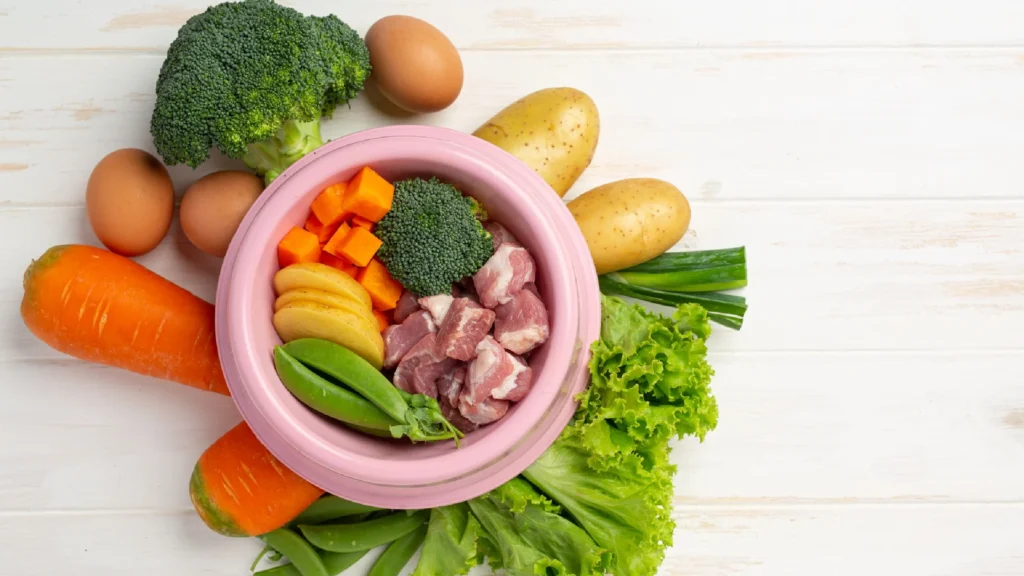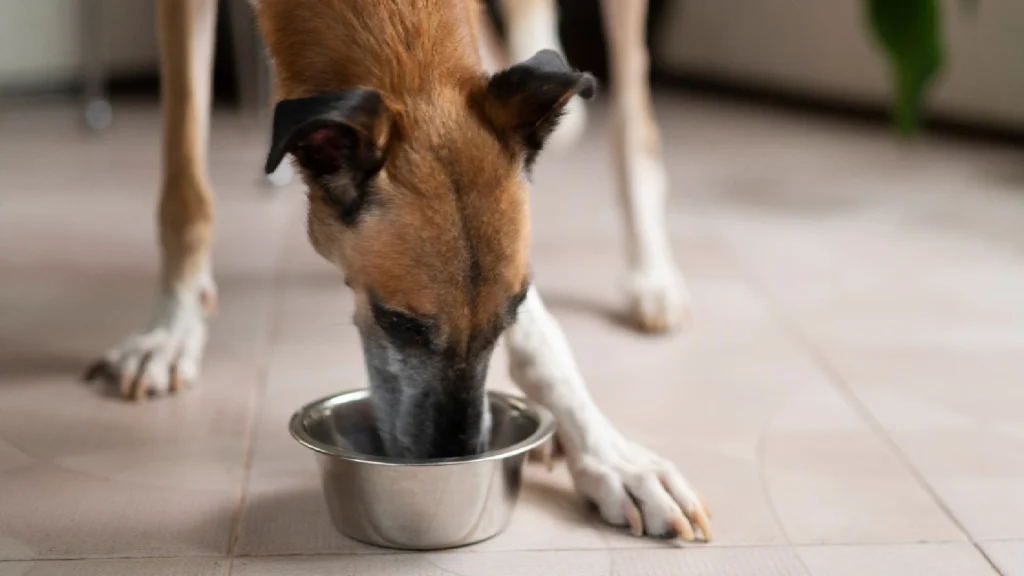
Introduction
Picture this: your furry friend eagerly sits by your side, eyes fixed on every morsel of food that enters your mouth. As a responsible pet owner, you may find yourself wondering, “Can Dog Eat Celery?” It’s no secret that dogs are curious creatures, always ready to explore new flavors. But when it comes to certain human foods, it’s important to consider their impact on canine health. In this article, we delve into the world of celery and uncover whether this leafy green is a safe and healthy treat for your beloved four-legged companion. So, let’s embark on this crunchy journey and discover the secrets behind dogs and celery consumption.
The Nutritional Profile of Celery
Celery, often lauded for its crisp texture and refreshing taste, is not only a favorite among health-conscious humans but also boasts a range of nutritional benefits. Before we explore its potential impact on our furry friends, let’s take a closer look at the nutritional profile of celery.
One of the remarkable aspects of celery is its low-calorie nature, making it a popular choice for those seeking a guilt-free snack. Each crunchy stalk contains a mere handful of calories, making it a great option for dogs that require weight management or are on a calorie-restricted diet.
Beyond its caloric content, celery is rich in essential vitamins and minerals. It is a notable source of vitamin K, which plays a crucial role in blood clotting and bone health. Additionally, celery contains vitamin A, which supports vision, immune function, and skin health.
Furthermore, this leafy green is packed with minerals such as potassium, which helps maintain proper heart function and electrolyte balance. It also contains folate, an important nutrient for cell growth and development, as well as dietary fiber, which aids digestion and promotes bowel regularity.
Celery’s hydrating properties cannot be overlooked either. With its high water content, this vegetable can contribute to your dog’s overall hydration, particularly during hot summer months or after vigorous exercise.
While these nutritional attributes make celery an appealing option for humans, let’s explore whether these benefits extend to our canine companions. In the next section, we’ll uncover whether dogs can safely partake in the crunchy goodness of celery or if caution should be exercised.
Can Dogs Eat Celery?
Can dogs eat celery? The answer is a resounding yes! Celery is generally safe for dogs to consume and can even provide some health benefits. However, it’s important to introduce celery to your dog’s diet in moderation and observe their individual response.
When introducing any new food to your dog, it’s essential to consider their specific dietary needs, allergies, and any existing health conditions. Before adding celery to your dog’s menu, it’s wise to consult with your veterinarian to ensure it aligns with their overall diet and well-being.
Celery can offer several potential benefits for dogs. Firstly, its high water content can contribute to your furry friend’s hydration, especially during warmer weather. Adequate hydration is crucial for maintaining optimal organ function and overall health in dogs.
Moreover, the natural crunchiness of celery can provide a form of mental and physical stimulation for dogs. Chewing on celery stalks can help satisfy their natural urge to gnaw and can be a healthy alternative to destructive chewing behaviors.
Additionally, celery can contribute to good oral health in dogs. The fibrous texture of celery can help clean your dog’s teeth and gums, reducing plaque buildup and promoting fresh breath. It’s important to note, however, that celery should not replace regular dental care practices such as brushing your dog’s teeth.
While celery offers potential benefits, it’s important to exercise caution and take a few precautions. Firstly, always remove any leaves, as they can be more challenging to digest and potentially pose a choking hazard. Stick to feeding your dog the crunchy stalks, which are easier for them to chew and digest.
Furthermore, moderation is key. Celery should be offered as a snack or occasional treat and should not replace a balanced and nutritionally complete diet specifically formulated for dogs. Overfeeding celery or any other food can lead to digestive issues or an imbalance in nutrient intake.
Lastly, if you notice any adverse reactions in your dog after consuming celery, such as vomiting, diarrhea, or unusual behavior, discontinue its consumption and consult your veterinarian. Every dog is unique, and individual sensitivities or allergies can occur.
In conclusion, dogs can indeed enjoy the satisfying crunch of celery as part of a balanced diet. It can contribute to hydration, provide a healthy chewing outlet, and potentially aid in oral health. However, remember to introduce it gradually, remove leaves, offer in moderation, and closely monitor your dog’s response. As always, consult your veterinarian to ensure celery is suitable for your dog’s specific needs.
Potential Risks and Precautions
While celery can be a safe and healthy addition to your dog’s diet, it’s essential to be aware of potential risks and take necessary precautions. Here are some important factors to consider:
- Choking Hazard: Celery stalks, especially if not properly cut or if the fibers are long and stringy, can pose a choking risk to dogs, particularly those prone to gulping down their food. To minimize this risk, ensure that the celery pieces are cut into small, manageable sizes that your dog can comfortably chew and swallow.
- Digestive Issues: Introducing any new food into your dog’s diet can potentially cause digestive upset, including diarrhea or vomiting. When introducing celery, start with small quantities and observe how your dog reacts. If any digestive issues occur, it may be a sign that celery doesn’t agree with your dog’s stomach, and you should discontinue its consumption.
- Allergic Reactions: While relatively rare, some dogs may have allergies or sensitivities to celery. Watch out for signs of allergic reactions such as itching, skin rashes, swelling, or difficulty breathing. If you suspect an allergic reaction, consult your veterinarian immediately.
- Pesticides and Herbicides: Celery, like many other fruits and vegetables, can contain traces of pesticides or herbicides. It’s advisable to choose organic celery or thoroughly wash conventionally grown celery before offering it to your dog. This helps minimize the potential exposure to harmful chemicals.
- Individual Considerations: Every dog is unique, with varying sensitivities and dietary needs. Some dogs may have underlying health conditions that make celery unsuitable for them. For example, dogs with certain gastrointestinal issues, such as pancreatitis or irritable bowel syndrome, may need to avoid high-fiber foods like celery. Consult with your veterinarian to determine if celery is appropriate for your dog’s specific circumstances.
To ensure your dog’s safety, it’s crucial to exercise caution, monitor their response, and make informed decisions when introducing celery or any new food to their diet. Remember that moderation and proper preparation are key to minimizing potential risks and maximizing the benefits of celery for your canine companion.
Serving Celery to Dogs
When it comes to serving celery to dogs, there are a few important considerations to keep in mind to ensure their safety and enjoyment. Here are some guidelines to follow:
- Preparation: Before offering celery to your dog, make sure to wash it thoroughly to remove any dirt, pesticides, or herbicides that may be present. Organic celery or celery from trusted sources is a good option to minimize exposure to harmful substances. Remove any leaves, as they can be tougher to digest and may pose a choking hazard.
- Size and Texture: Cut celery stalks into appropriately sized pieces that are easy for your dog to chew and swallow. The size of the pieces will depend on your dog’s size and chewing ability. Smaller dogs may require smaller, bite-sized pieces, while larger dogs can handle slightly larger portions. Aim for manageable sizes that reduce the risk of choking.
- Standalone Snack or Ingredient: You can serve celery to your dog as a standalone snack or incorporate it into their meals. If offering it as a snack, provide a few pieces at a time, especially if it’s the first time your dog is trying celery. Alternatively, you can chop or dice celery and mix it with other dog-friendly ingredients to create homemade treats or add it to their regular meals.
- Moderation: While celery can be a healthy addition to your dog’s diet, remember to offer it in moderation. Treat celery as a snack or occasional treat rather than a staple food. It should not make up a significant portion of their daily caloric intake. A balanced and nutritionally complete diet formulated for dogs should remain the primary focus of their meals.
- Individual Dietary Needs: Consider your dog’s specific dietary needs and any preexisting health conditions. If your dog has weight management concerns, consult with your veterinarian to determine the appropriate portion sizes and frequency of celery consumption. Dogs with certain health conditions, such as diabetes or kidney disease, may require more tailored dietary considerations, so it’s essential to seek professional advice.
- Observation: Pay close attention to how your dog responds to celery. Observe for any signs of digestive upset, such as diarrhea or vomiting, and monitor their chewing and swallowing behavior to ensure they can handle the celery pieces comfortably. If you notice any adverse reactions or difficulties, discontinue offering celery and consult your veterinarian.
Remember, each dog is unique, and what works well for one may not work for another. By considering your dog’s individual needs, serving celery in an appropriate manner, and closely monitoring their response, you can safely incorporate this crunchy vegetable into their diet and provide them with a flavorful and nutritious treat.
Observing Your Dog’s Response
Observing your dog’s response to new foods, such as celery, is crucial to ensure their well-being and safety. Here are some key aspects to consider when observing your dog’s reaction:
- Digestive Health: After your dog consumes celery, monitor their digestive system. Look for any signs of digestive upset, such as diarrhea, vomiting, or excessive gas. If you notice any abnormalities, it may indicate that celery doesn’t agree with their stomach, and you should discontinue its consumption.
- Chewing and Swallowing: Pay attention to how your dog chews and swallows celery. Ensure they can comfortably chew the celery pieces and don’t exhibit any signs of struggling or discomfort. If you notice difficulties in chewing or swallowing, it’s important to adjust the size or texture of the celery to make it more manageable for your dog.
- Allergic Reactions: Keep an eye out for any signs of allergic reactions. These may include itching, redness, swelling, hives, or respiratory distress. If you observe any of these symptoms, discontinue giving celery to your dog and consult with your veterinarian to address the allergic response.
- Behavioral Changes: Observe your dog’s behavior after consuming celery. Look for any signs of restlessness, lethargy, excessive thirst, or unusual behavior. While rare, some dogs may have individual sensitivities or reactions to certain foods, including celery.
- Individual Sensitivities: Remember that each dog is unique, and their tolerance to certain foods may vary. Some dogs may have preexisting health conditions or sensitivities that make celery unsuitable for them. Consult with your veterinarian to determine if celery is appropriate for your dog’s specific circumstances.
By closely observing your dog’s response to celery, you can determine whether it is a safe and enjoyable addition to their diet. If you have any concerns or doubts, consulting with your veterinarian is always recommended to ensure the well-being of your beloved furry companion.
Conclusion
In conclusion, the question “Can dog eat celery?” can be answered with a resounding yes. Celery can be a safe and healthy addition to your dog’s diet when offered in moderation and with proper precautions.
Celery brings several potential benefits to your furry friend. It is hydrating, provides a healthy chewing outlet, and can contribute to good oral health. However, it’s important to be aware of the potential risks associated with celery consumption, such as choking hazards and digestive issues.
By following the guidelines provided and considering your dog’s individual needs, you can safely serve celery to your canine companion. Remember to prepare celery appropriately, offer it in manageable sizes, and incorporate it into their diet as a snack or occasional treat.
As with any dietary changes, closely observe your dog’s response to celery consumption. If you notice any adverse reactions or concerns, consult with your veterinarian. They can provide tailored advice based on your dog’s specific health requirements.
Ultimately, responsible pet ownership involves making informed decisions about your dog’s diet. While celery can be a healthy addition, it should never replace a balanced and nutritionally complete diet specifically formulated for dogs.
So, the next time you’re enjoying some celery, consider sharing a crunchy stalk with your canine companion. With the right approach, you can treat your furry friend to a flavorful and nutritious snack that adds variety to their diet and keeps their tail wagging with delight.
Read More
- The Ultimate Guide: Unveiling the Best Ingredients for a Healthy and Happy Dog
- 5 Dog Food Ingredients to Avoid for a Healthy Canine Diet




